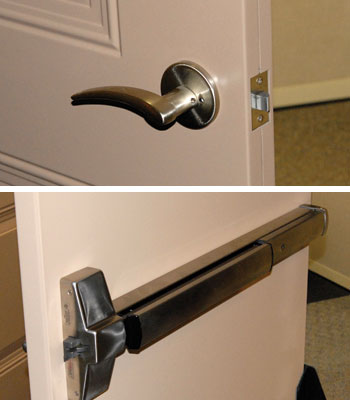Aesthetically Designed Architectural Door Openings
Inside the door, a core material needs to be inserted to provide integrity to the metal panels which can be specified to meet the specific performance requirements of the door. The common core choices include an open honeycomb fiberboard, solid polystyrene foam, polyurethane foam, solid mineral fiberboard, or a steel stiffened core. The choice of the core material will likely be the determinant of how the door performs in terms of fire rating, energy efficiency, sound transmission, overall strength, and even blast resistance. Since the core is then covered over by the selected metal faces, making it completely concealed, the design aesthetic is maintained regardless of the core selection made.
 |
Hollow metal doors can be finished with exposed edge seams (top) or filled seams that are ground smooth (bottom). Photos courtesy of ASSA ABLOY |
One important aesthetic detail on hollow metal doors is the manner in which the edges of the door are treated. This is the area where the front and back panels come together and meet at or near the center of the door thickness. The specification choices include exposed seams, which produce a visible line or ridge at the side, top, and bottom of the door. The alternative is to specify that the edges be filled and ground smooth to eliminate the seams and create a more refined appearance.
Aluminum Doors
When aluminum doors are used, they are typically mostly or fully glazed, assembled, and packaged at the factory, complete with the frame. They also typically include accommodations for any special hardware preparation, thus making installation easier on site. Aluminum door types in particular are not limited to swinging doors but can be selected in a sliding barn door type or a pocket door type. Aluminum doors are commonly available in narrow (2-1/8 inches), medium (4-¼ inches), and wide stiles (5-½ inches).
Wood Doors
There are many choices and aesthetic options when the overall design calls for wood doors. The first and most basic choice is whether to use smooth flush doors or to incorporate a more three-dimensional stile and rail pattern into the doors. Stiles are the vertical support portions of the door on the sides. The rails are horizontal supports appropriately referred to by their location on the door such as top rails, bottom rails, and cross rails for intermediate locations. Either door type can create traditional or contemporary solutions, so an understanding of the possibilities becomes important in order to create door openings that truly work with the rest of the interior design.
For flush doors, the door face is obviously the most visible element with the biggest design impact. The face is typically a wood veneer over a substrate or crossband layer. That veneer can be any of a wide variety of species of wood, from almost any type of tree. When the wood is cut from the log, it can be done in a variety of ways that produce different wood grain appearances and different sizes of veneer pieces. The size of those pieces will determine whether the door appears with a single wood grain pattern or if several pieces are matched together to create other aesthetics. Hence the commonly used book-match or slip-match patterns of veneer can be selected instead of a full veneer piece. Custom or standard decorative patterns are possible that use multiple pieces of veneer, sometimes with multiple wood species, to create free form or geometric pattern to produce very artistically inspired results.
 |
A fully integrated door opening blends seamlessly with the rest of the interior design while still meeting the functional, safety, and code requirements of the space. Photo courtesy of ASSA ABLOY |









